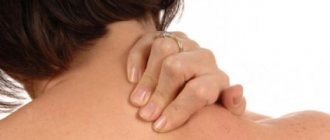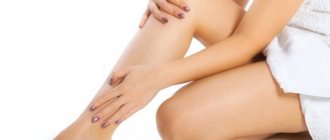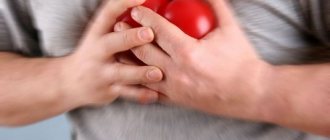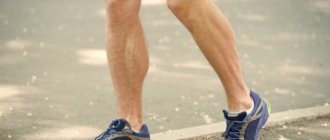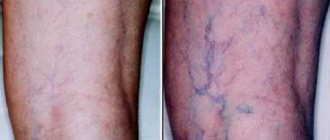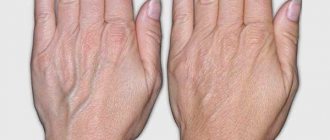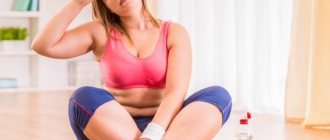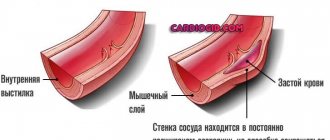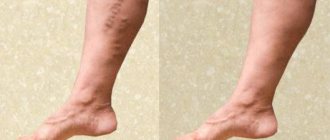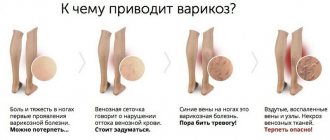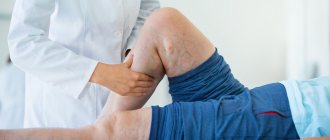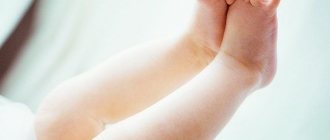Swelling of the veins of the lower extremities is one of the clinical signs of varicose veins, which most people do not take seriously enough, putting off going to the doctor. It is not the disease itself that is dangerous, but the complications that develop against its background in the form of thrombophlebitis, characterized by the formation of blood clots that, blocking the venous lumen, impair blood circulation.
The greatest danger lies in the possible detachment of a blood clot from the vascular wall and its further penetration into the lungs. This leads to pulmonary embolism and death.
According to statistics, almost a third of the world's population today suffers from varicose veins and its symptoms. This condition requires consultation with a phlebologist and blood tests for blood clotting. After the examination, comprehensive treatment of the pathology is prescribed.
Bulging vein in the leg
Causes of the pathological condition
Swelling of the veins in the legs is more common in women and older people, which is due to the aging process of the body, in particular the wear and tear of the cardiovascular system. But there are many other factors that adversely affect the venous system:
- High physical activity – constant carrying of heavy objects, work “on your feet” without sufficient rest lead to. More common among professional athletes.
- Hereditary factor – if close relatives have venous pathology, the risk of developing the disease increases. In this case, bloating of the veins can occur in childhood. The cause is increased weakness of the vascular walls due to insufficiency of connective tissue.
- Lack of physical activity (sedentary work).
- High-heeled shoes, tight and constricting clothing.
- A woman's pregnancy period.
- The predominance of fatty foods, high in cholesterol, and lack of vitamins lead to weakening of the venous walls and deterioration of blood outflow.
- The presence of harmful habits - drinking alcohol, drugs, smoking, all these factors have a detrimental effect on the veins and lead to disruption of the heart.
- The risk group includes people who have developed a persistent habit of throwing one leg over the other and spending a long time in this position. This leads to impaired blood circulation and decreased elasticity of the vascular walls.
Partner advertising
Diagnostics
At the initial stage, especially with minor manifestations of venous circulation disorders, diagnosis is difficult. However, phlebologists are able to determine the onset of the disease based on characteristic signs and with the help of special examinations. Doppler ultrasound provides comprehensive information about the state of venous blood flow in the lower extremities.
A blood test is required. To diagnose varicose veins, the blood sugar level is important; for this purpose, an analysis for glycated hemoglobin is performed. The number of leukocytes will indicate the presence of infection. If a patient consults a doctor because of swollen veins in the legs, they will undergo tests to determine the presence of blood clots.
To determine the condition and patency of the deep veins, use:
- Delbe-Perthes marching test. It consists of applying a tourniquet to the patient closer to the groin, which compresses only the superficial veins. If after 3-5 minutes of walking they empty and subside, it means that the deep veins are passable. If the veins under the skin swell, it means that the blood flow in the deep veins is impaired.
- Test for Lowenberg's symptom. A sphygmomanometer cuff is placed on the patient's lower leg and the pressure is inflated to 150 mmHg. If before reaching this figure the patient begins to experience severe pain in the calf, this indicates deep vein thrombosis.
- Homans test. The patient lies on his back and does not fully bend the affected leg at the knee. The doctor presses the foot in the dorsal direction. Pale spots that appear on the calf and acute pain indicate the presence of a blood clot.
- The Moses test consists of sequential compression of the lower leg from the front and back, then in the same place from the sides. Pain during the first manipulations and its absence during lateral compression means that the process of thrombus formation is underway.
If the patient's test results are negative, but there is pain and a feeling of fullness in the leg, instrumental examinations are prescribed. One of the most reliable is phlebography. It consists of an x-ray of blood vessels with the introduction of a contrast agent into them.
Indications for this procedure are:
- negative test results;
- bloating of veins and signs of tissue trophic disturbances;
- leg ulcers of unknown origin.
The task of phlebography is to determine the degree of damage to the deep veins, visualize anomalies in the structure of the venous walls, and the condition of the communicating vessels (connecting the deep and superficial veins). The study is not carried out for pregnant women, elderly people and those with atherosclerosis of the blood vessels of the legs.
Clinical manifestations and diagnosis
A swollen vein is not the only sign of the onset of pathological changes; as a rule, other symptomatic manifestations of varicose veins also appear:
- constant feeling of fatigue in the lower extremities;
- muscle tone increases;
- periodic feelings of soreness and heat develop;
- swelling of the legs;
- muscle cramps.
A swollen vein causes significant discomfort, spoils the aesthetic appearance, and is often accompanied by pain. Before starting treatment, a comprehensive examination is carried out, including:
- blood clotting test;
- angiography;
- Ultrasound with Doppler;
- functional tests.
Symptoms
Recognizing varicose veins in time is not as easy as it might seem at first glance. If you find yourself with one of the symptoms below, you should immediately consult a phlebologist.
- The veins in the legs below the knee swell, and a slight swelling of the soft tissues appears.
- The muscles of the lower extremities are in constant tension.
- From time to time, short cramps occur in the legs.
- After a day of work, you feel tired and completely overwhelmed.
- The skin on my legs became darker and itched.
- In the evening, the vascular network begins to swell.
A doctor can make an accurate diagnosis only after a thorough examination and study of test results. It is best to start treating varicose veins at the initial stage, so you should not put off going to the doctor for long.
Treatment for a swollen vein
As a rule, when a vein is swollen, a person feels constant pain, discomfort and fatigue, which interferes with the usual way of life. Therefore, initial measures are aimed at eliminating pain, swelling and reducing inflammation.
To eliminate pain, swelling and reduce inflammation, local treatment is prescribed using various ointments and gels. Among the most popular are preparations based on Heparin (Lioton-gel, Troxevasin, Heparin ointment).
Treatment of a swollen vein: troxevasin and heparin ointment
A high effect is observed when using compression treatment. Its action is aimed at reducing the diameter of veins, improving blood circulation and lymphatic drainage. Elastic bandages or special compression garments are used for the lower extremities.
It is also recommended that people whose professional activities involve increased physical activity take a body position every evening in such a way that their legs rise 10-15 cm above the body. To do this, you can place several pillows under your feet and shins or use a bolster. This procedure has a positive effect on blood vessels, improving blood flow and reducing congestion. You can also use various compresses and rubs made from honey, clay, apple cider vinegar, and alcohol tincture on horse chestnut fruits.
In complex therapy, antihistamines are used to eliminate irritation and swelling: Loratadine, Claritin, Suprastin. If these medications are not available, cold compresses can be used. To do this, wrap the ice in a towel and apply it to the sore area.
It is very important to adjust the diet, especially for patients who are overweight. The daily diet includes vegetables, fruits and berries, and a sufficient amount of water.
All dishes should be cooked boiled or steamed; fatty foods, smoked foods, salty foods, and flour products are excluded.
Treatment options
It is impossible to cure varicose veins; doctors can only stop the development of the pathology and maintain the vessels in more or less working condition. This approach gives a good result only with the active participation of the patient, who strictly follows all instructions and recommendations.
Bulging veins in the legs are treated in several ways, depending on the extent of the damage - conservatively or surgically. A mandatory element of treatment is wearing tight knitwear or using an elastic bandage. Traditional medicine recipes are used as auxiliary symptomatic treatment.
Conservative methods
Conservative treatment is carried out in the initial stages of the disease, when compression and drug therapy can restore the elasticity of the venous walls, relieve inflammation and prevent the formation of blood clots.
When veins swell, a person experiences pain. The goal of treatment is to relieve him of discomfort. For this purpose, drugs of the following pharmacological groups are used:
- venotonics, which increase the elasticity of blood vessels and strengthen their walls;
- angioprotectors that protect veins from inflammation;
- anticoagulants and antiplatelet agents that thin the blood and prevent the accumulation and adhesion of platelets in areas of inflammation in the vessels.
If severe itching bothers you, antihistamines are prescribed. Medicines can be intended for oral administration and external use. Some of them have a combined effect. The most popular drugs are Detralex, Troxevasin, Venarus, Lyoton 1000, Phlebodia 600, ointments containing heparin.
Part of conservative therapy is special gymnastics that allows you to normalize venous and lymphatic outflow, improve the condition of blood vessels, and increase the flow of arterial blood rich in oxygen.
Compression jersey
When veins become diseased, they require external support. Compression hosiery acts as a frame that supports the muscles. How does stretching help:
- supports weak lower leg muscles - the intensity of blood flow directly depends on their tone;
- prevents vascular walls from stretching;
- prevents stagnation of blood and lymph, stimulating their outflow.
Depending on the location, tights, stockings and knee socks are used. Knitwear differs in the degree of compression. It should be recommended by a doctor depending on the condition of the veins.
Folk remedies against varicose veins
Varicose veins respond well to treatment with traditional medicine. They relieve unpleasant symptoms - pain, swelling, heaviness in the legs. By using them in combination, you can reduce inflammation in the veins and increase blood flow. Traditionally used:
- fruits, flowers and seeds of horse chestnut;
- Apple vinegar;
- green tomatoes;
- Kalanchoe leaves;
- herbs - chamomile, yarrow, nettle, plantain, raspberry leaf, horsetail, Icelandic white moss.
A tincture is prepared from horse chestnut or juice is squeezed from the flowers. Tomatoes and Kalanchoe are used externally in the form of rubbing and compresses. Herbs are used to make decoctions and infusions for oral administration and compresses.
Surgery
When conservative treatment methods fail and the disease begins to progress, surgical intervention is resorted to. It comes in varying degrees of complexity and is performed using modern high-tech techniques.
Radiofrequency ablation
Phlebologists borrowed this method from cardiologists. It is performed using high frequency current. An electrode is inserted into the vein to the length that corresponds to the affected area. The high-frequency current heats the walls of the vessel to 120˚C, sclerosing and removing it from the bloodstream. This method of treatment is used for moderate vein disease.
Sclerotherapy
Treatment of swollen limbs using sclerotherapy is carried out in several stages. The procedure cannot be considered a full-fledged surgical intervention. It is almost painless and is not contraindicated even for children.
A substance called sclerosant is injected into the diseased vein using a needle. Under its action, the vein sticks together, and the blood flow is redirected through healthy vessels. With this method, venous enlargement is treated in the early stages of the disease.
Laser coagulation
The most effective and popular method of treating vascular pathology is laser coagulation. It has a number of advantages:
- short duration of the procedure;
- pronounced therapeutic and cosmetic effect;
- short recovery period;
- minimal risk of complications.
Unlike other methods, laser coagulation can be performed for trophic skin lesions. A laser light guide is inserted into the vessel through a catheter. A directed flash of light seals the vessel. Lasers are not used in the treatment of multiple vein lesions due to the high cost of the operation.
Conservative treatment
Drug treatment plays an important role, which is necessary to reduce inflammation, swelling, pain, as well as to strengthen the walls of blood vessels, increase their elasticity, and normalize blood circulation. To treat swollen veins, venotonics are prescribed - Phlebodia, Detralex, Venuruton.
Maintenance treatment consists of:
- constant or periodic wearing of compression hosiery (stockings, knee socks, tights);
- a healthy diet with a sufficient amount of vitamins and the exclusion of fatty, fried, smoked foods;
- performing therapeutic exercises;
- swimming lessons, which improve blood circulation and metabolic processes in the body, increase immunity, and strengthen muscles.
May be of interest:
|
Prevention
You need to start exercising before varicose veins appear. This is especially important for those who have a predisposition to vascular pathologies.
The question of what to do if the veins in the legs are swollen appears after the problem appears. In fact, the problem can be eliminated long before it appears if you begin to follow preventive measures in advance.
Prevention measures:
- Dietary recommendations - the diet should contain more seafood and natural foods. It is advisable to completely avoid fatty and spicy foods. Try not to eat food with a large number of food additives, especially E-components. People prone to being overweight need to exclude foods with high cholesterol levels from their diet;
- therapeutic exercises - when working sedentarily, it is necessary to regularly do a special warm-up every 2 hours. When standing, you need to rest your legs every 2 hours 15-20 minutes. It is advisable that during rest the legs should be thrown back above the pelvis. This position is considered the most effective for relaxation and rest;
- playing sports is an excellent way to prevent bloating; a short daily jog in the fresh air. It will not only tighten your muscles, improve your health, but also improve your mood. Doing yoga will improve blood circulation.
For prevention, it is useful to use foot massage, contrast showers and hardening.
Compression sclerotherapy
Sclerotherapy involves the introduction of a special solution into the lumen of a pathologically dilated vein. The drug is administered using a syringe, then fills the vessel and causes its sclerosis (fusion of the venous walls).
After the procedure, compression stockings are placed on the leg to speed up the gluing process. Within 2-3 days, the venous walls grow together. To consolidate the result, wearing compression hosiery continues for 5-6 weeks, until dense adhesions form.
Examination by a phlebologist
At the first examination, the doctor will ask about the symptoms of leg disease and the duration of the swelling of the veins. You should ask your parents in advance if they have any problems with blood vessels. This is very important, since varicose veins that develop on the legs have a genetic predisposition and can be passed on even through generations.
The patient is examined in a supine position in the presence of good lighting. The phlebologist will pay attention to every swollen vessel in the leg, any compaction, blueness and swelling. A significant role in the examination is given to the place where the dilated veins are located. Based on this, the doctor will be able to draw a conclusion about the cause of the development of varicose veins and the possible consequences for the body.
Surgical treatment
In case of pronounced pathological changes in the veins, accompanied by swelling and pain, surgical intervention is prescribed. The essence of the technique is to remove or seal the affected vessel. There are various methods of performing the operation. Today, the least traumatic methods have achieved the greatest popularity:
- stripping is an operation during which a pathologically altered vein is removed; To do this, several small incisions are made through which a probe is inserted and manipulation is carried out;
- endovasal laser coagulation (EVLC) - a microscopic incision is made in the skin, into which the doctor inserts a special device - a light guide; With the help of laser irradiation, pathologically changed areas are sealed and blood begins to circulate through healthy veins.
During the recovery period, medications are prescribed to normalize blood circulation, diet, and reduce any physical activity.
Swelling of veins in other areas
Varicose veins can also occur in other areas of the patient's body where large veins pass.
- Varicose veins in the temples usually occur in old age against the background of hypertension and other diseases. The pathology can lead to loss of vision in one eye and provoke severe throbbing pain in the patient.
- Varicose veins of the esophagus are extremely dangerous, as they are fraught with complications in the form of internal bleeding with subsequent death. The main cause of pathology is liver disease.
- The consequence of impaired blood circulation is varicose veins in the patient’s facial area. They may look like stars or meshes. In most cases, the defect is not dangerous from a medical point of view, but causes cosmetic damage.
- Enlarged veins in the neck may be associated with blood pressure or poor circulation.
- Varicose veins in the arms are formed due to overexertion of the patient. Young people who engage in bodybuilding incorrectly and abuse dietary supplements to build muscle mass are susceptible to the disease.
- Varicose veins of the uterus are dangerous due to the difficulty of diagnosing them. The first symptoms of pathological vasodilatation are similar to gynecological problems. In the future, the pathology leads to severe pain, especially when lifting heavy objects.
Depending on the location, varicose veins can disturb nearby organs; swollen veins are extremely unsightly from an aesthetic point of view, so it is recommended not to ignore this syndrome, but to engage in timely treatment.
Traditional methods of therapy for a swollen vein
Recipes based on herbal plants are used to make compresses and lotions, as well as for oral use. This therapy is aimed at reducing the manifestations of varicose veins - inflammation, discomfort, fatigue, pain, swelling, strengthening the venous walls and normalizing the outflow of venous blood.
Before using traditional recipes, it is recommended to consult with your doctor.
The use of drugs based on herbal components is prohibited for patients suffering from hypersensitivity to substances of plant origin.
The following methods are considered the most popular:
- tincture based on white acacia inflorescences in alcohol - for preparation, the flowers are placed in a bottle and filled with alcohol (vodka), after which they are infused in a dark place for two weeks; rub your feet with the solution before going to bed, paying special attention to the affected areas, the course of treatment is 3-4 weeks;
- medicine based on horse chestnut for oral use - the inflorescences are poured with alcohol and left for two weeks in a cool place, hidden from sunlight, shaking daily; the tincture is filtered through gauze folded in four layers; take 1 tbsp. l. 3 times during the day before meals;
- applying honey compresses - rub the affected areas with liquid honey, wrap them with cling film and a warm scarf (towel); Treatment is carried out according to the scheme - the first procedure lasts no more than 2 hours, the second and third - four hours each, the fifth is performed at night.
Treatment
It should be noted that varicose veins do not go away on their own, and therefore, in order to prevent the disease from developing to late stages and complications, it is necessary to begin treatment in a timely manner. In the initial stages, you can do without surgery, and if intervention is still recommended, it will be minimally invasive. If the disease is advanced, you will have to resort to classic phlebectomy. This type of operation is the most radical way to solve the problem.
Before prescribing treatment to a patient, he is examined by a doctor and sent for a diagnostic examination. Diagnostics include Doppler or duplex sonography, computed tomographic venography, magnetic resonance venography and other procedures at the discretion of the physician.
Conservative treatment
One of the key problems that needs to be solved with varicose veins is the elimination of discomfort in the patient. This cannot be called a treatment for varicose veins - these are only actions aimed at relieving the symptoms of the disease. However, one of the doctor’s tasks is to provide the patient with a decent quality of life during the period of treatment and reduce the unpleasant manifestations of the disease, which is a completely solvable task. Also, drug therapy allows you to consolidate the effect of treatment in other ways.
There are such methods of conservative treatment:
- Painkillers. Medicines can reduce the symptoms of the disease. However, it is undesirable to get too carried away with them, both because of addiction to the drugs and because of the side effects from their use.
- General purpose drugs that ensure normal blood circulation in the lower extremities. Such drugs improve the overall therapeutic effect of other treatment methods. Among the drugs in this group we can note such as Phlebodia, Venoruton, Detralex.
- Preparations for external use, including creams, ointments, gels. Such medications can relieve swelling, heaviness and pain in the lower extremities.
- Antihistamines, for example, Suprastin, can reduce pain and relieve itching. If this or a drug similar in its effect is not at hand, you can use toothpaste to rub the affected area.
- Traditional medicine. Compresses, baths, lotions and rubbing are used. Among the products popular in the fight against varicose veins are apple cider vinegar, honey, chestnut, clay, greenish tomatoes, and laundry soap.
- Dieting. It is important to properly organize your diet, avoiding foods with high cholesterol levels. In addition, a balanced diet allows you to control your weight, which is especially important for varicose veins, as it reduces the load on your legs.
- Compression underwear. Special compression knitwear (if it is not available, you can use a standard elastic bandage) allows you to maintain the veins in the correct position, which makes the course of the disease easier. The degree of compression should be determined by a doctor, since too much compression can lead to a worsening of the patient's condition. Compression underwear is prescribed only if there is no danger of thrombophlebitis.
- Raising the legs above the level of the heart improves blood flow, resulting in less discomfort in the legs. It is recommended to periodically raise them during the day, and also place them above the body during sleep.
- Moderate physical activity allows you to optimize blood circulation in the legs. Walking, swimming, therapeutic exercises and some other types of exercise are allowed in consultation with the attending physician.
Note! Thermal procedures for varicose veins are strictly not recommended. After a hot bath or sauna, the veins protrude more, and pain appears in the legs. In addition, elevated temperature provokes the accelerated development of pathology.
Conservative treatment of varicose veins is a long process. The task of the patient and the doctor is the need to maintain the normal state of the vascular system in order to prevent the acceleration of the development of the disease and the onset of complications.
Note! Effective treatment of varicose veins is always a complex task. The disease cannot be cured with medications or compression garments alone. You will need to switch to a healthy lifestyle: start eating right, moving more, giving up bad habits.
Surgery
If conservative therapy for varicose veins does not bring results, the disease is actively progressing or a complication occurs, surgery cannot be avoided. The goal of surgical intervention is to exclude the affected vein from the blood flow system.
There are two types of operations - radical (classical phlebectomy) and minimally invasive (sclerotherapy, laser therapy, miniphlebectomy, stripping). Minimally invasive techniques are not traumatic and are easily tolerated by patients, but are applicable only in the early stages of varicose veins. If the process has gone far, you will have to do a radical operation.
The main preventive rule is to try in advance to avoid or exclude from your life any provoking factors that can lead to the appearance and development of varicose veins. If any symptoms of varicose veins are detected, you should not delay visiting a doctor, because the sooner treatment is started, the easier it is to cope with the problem.
Dopplerography and ultrasound
After palpating the outer integument of the leg and examining the patient, the doctor refers the patient to ultrasound and Dopplerography. Ultrasound gives the doctor the opportunity to examine the affected areas in a cross-section, and duplex or triplex examination allows you to assess the damage, determine the presence of reverse blood flow and blood clots that caused the bloating.
Doppler ultrasound is performed by injecting a special contrast agent into the patient's leg, which can then be observed on a screen using ultrasound. It changes the color of the vascular walls in the area of bulging veins, which allows you to clearly see problem areas.
Diagnosis of varicose veins of the lower extremities using Doppler ultrasound is divided into several types:
- triplex;
- duplex;
- impulsive-wave;
- energy;
- color.
Diagnosis of swollen veins and varicose veins of the legs using the color Doppler method shows the affected areas of the vessels on the screen, coloring them red or blue. During an energy study, the nature of the blood flow in the vessels is displayed; if it is slow, they will turn red, if it is too fast, they will turn yellow. This method gives the doctor an idea of whether there is any blood flow in the swollen veins and in what direction it is carried out. More accurate data on the speed of movement of blood fluid is provided by the pulsed wave technique. The triplex and duplex procedure is characterized by a combination of several methods.
The advantage of ultrasound examination is that it does not require insertion of a needle into the area of the affected limbs and is completely painless.
Traditional treatment
If self-treatment helps, you should not neglect medical advice. Traditional methods help get rid of pain, but home treatments will not cure the disease.
When veins begin to swell, people turn to a vascular surgeon. The doctor prescribes examinations, procedures, therapeutic and diagnostic. Then treatment is prescribed. Remember, surgery is an exceptional case. Treatment is complex and includes many options: from medications to physiotherapy to relieve sensations in the leg. You won’t be able to get rid of varicose veins in a week, but you don’t have to go to the hospital.
Typically treatment includes the following points:
- Taking general medications that support blood circulation and strengthen vascular walls;
- Taking selected painkillers and painkillers, on the affected leg and on the healthy one, after a prolonged lack of treatment, the second limb is often affected;
- Proper nutrition, in particular – reducing cholesterol. Restriction helps the veins and the body by reducing weight;
Proper nutrition - Wearing therapeutic underwear (preventing the development of thrombophlebitis);
- Complex of therapeutic exercises.
If it comes to surgery, it means that varicose veins have spread greatly and taken a serious turn. After the operation, a protracted course of rehabilitation will begin - he will now have to take care of his limbs for life.
What can you do yourself?
If the veins in the legs swell during pregnancy, then most of the above treatment methods remain prohibited. Expectant mothers can wear compression stockings and use veinotonics for certain periods. But in each case, the correction must be prescribed by a doctor.
In addition to the treatment methods described, what can be done for a bulging vein in the leg? Here are some tips given by phlebologists and vascular surgeons.
- Watch your diet. If you have varicose veins, you need to eat healthy foods. Give preference to fruits and vegetables. Forget about fast food, fatty, fried and spicy foods. Avoid alcohol and soda and don't overeat. Be sure to monitor your bowel movements regularly.
- Give your legs a rest. After a hard day's work, place your limbs above the level of your heart. This pose will increase the flow of blood from the feet. You may notice that the bulging vein has become sunken. Stay in this position for several minutes.
- Move more. If your job requires you to sit for a long time, then take more frequent walks. Ditch the car and walk to work. Swimming and cycling are good for strengthening the walls of blood vessels.
- Use traditional methods. Treatment of varicose veins can be combined with the use of traditional methods. This includes smearing the affected areas with chestnut tincture, applying honey cakes, and rubbing with herbal decoctions. But we must remember that these methods will not eliminate varicose veins without drug therapy.
Minimally invasive treatment methods: sclerotherapy and laser
If the veins in the legs are swollen, treatment can be carried out quickly and painlessly. A fairly effective and low-traumatic method is vein sclerosis and laser treatment.
For sclerosis, the doctor uses modern drugs, for example, Ethoxysklerol. The active substance enters the vessel and clogs it. Over time, the resulting hematoma turns into connective tissue. The affected vein stops functioning and bothers you.
Endovenous laser ablation is currently recognized as the most minimally traumatic method of treating varicose veins. Please note that this procedure is also expensive. Correction is carried out under the influence of lidocaine. Patients can return to their normal lifestyle on the same day.
